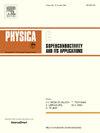Quantum fisher information reveals UV-IR mixing in the strange metal
IF 1
3区 物理与天体物理
Q4 PHYSICS, APPLIED
Physica C-superconductivity and Its Applications
Pub Date : 2025-06-18
DOI:10.1016/j.physc.2025.1354750
引用次数: 0
Abstract
The density-density response in optimally doped BiSrCaCuO has recently been shown to exhibit conformal symmetry. Using, the experimentally inferred conformal dynamic susceptibility, we compute the resultant quantum Fisher information (QFI), a witness to multi-partite entanglement. For a Fermi liquid, we find that the QFI grows quadratically as the temperature increases, consistent then with the phase space available for scattering in the standard theory of metals. By contrast, the QFI in a strange metal increases as a power law at as the temperature decreases, but ultimately extrapolates to a constant at . The constant is of the form, , where is the conformal dimension and is the UV cutoff which is on the order of the pseudogap. As this constant depends on both UV and IR properties, it illustrates that multipartite entanglement in a strange metal exhibits UV-IR mixing, a benchmark feature of doped Mott insulators as exemplified by dynamical spectral weight transfer. We conclude with a discussion of the implication of our results for low-energy reductions of the Hubbard model.
量子费雪信息揭示了这种奇怪金属中的紫外-红外混合
最佳掺杂Bi2Sr2CaCu2O8+x的密度-密度响应最近被证明具有保形对称性。利用实验推断的共形动态磁化率,我们计算了由此产生的量子费雪信息(QFI),这是多方纠缠的一个见证。对于费米液体,我们发现QFI随着温度的升高呈二次增长,这与金属标准理论中可用于散射的相空间一致。相比之下,在一种奇怪的金属中,QFI随着温度的降低呈幂律增加,但最终在T=0时外推为常数。该常数的形式为ωg2Δ,其中Δ是保形尺寸,ωg是与赝隙相同阶的UV截止值。由于该常数取决于紫外和红外特性,它说明了奇怪金属中的多部纠缠表现出紫外-红外混合,这是掺杂莫特绝缘体的基准特征,如动态光谱重量转移所示。最后,我们讨论了我们的结果对哈伯德模型的低能量减少的影响。
本文章由计算机程序翻译,如有差异,请以英文原文为准。
求助全文
约1分钟内获得全文
求助全文
来源期刊
CiteScore
2.70
自引率
11.80%
发文量
102
审稿时长
66 days
期刊介绍:
Physica C (Superconductivity and its Applications) publishes peer-reviewed papers on novel developments in the field of superconductivity. Topics include discovery of new superconducting materials and elucidation of their mechanisms, physics of vortex matter, enhancement of critical properties of superconductors, identification of novel properties and processing methods that improve their performance and promote new routes to applications of superconductivity.
The main goal of the journal is to publish:
1. Papers that substantially increase the understanding of the fundamental aspects and mechanisms of superconductivity and vortex matter through theoretical and experimental methods.
2. Papers that report on novel physical properties and processing of materials that substantially enhance their critical performance.
3. Papers that promote new or improved routes to applications of superconductivity and/or superconducting materials, and proof-of-concept novel proto-type superconducting devices.
The editors of the journal will select papers that are well written and based on thorough research that provide truly novel insights.

 求助内容:
求助内容: 应助结果提醒方式:
应助结果提醒方式:


